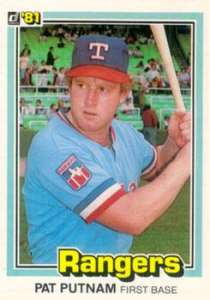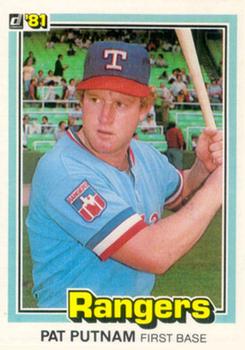Pat Putnam
 From his humble start in the Shelburne Little League, Pat Putnam developed into a left-handed power hitter who played first base and designated hitter for eight years in the major leagues. Although he enjoyed several fine seasons with the Texas Rangers and Seattle Mariners, the former first-round draft choice, Minor League Player of the Year and A.L. Rookie of the Year never quite achieved the stardom many had predicted for him. After finishing his career in baseball with two seasons in Japan, Putnam returned to Fort Myers, Florida, where he had moved as a child.
From his humble start in the Shelburne Little League, Pat Putnam developed into a left-handed power hitter who played first base and designated hitter for eight years in the major leagues. Although he enjoyed several fine seasons with the Texas Rangers and Seattle Mariners, the former first-round draft choice, Minor League Player of the Year and A.L. Rookie of the Year never quite achieved the stardom many had predicted for him. After finishing his career in baseball with two seasons in Japan, Putnam returned to Fort Myers, Florida, where he had moved as a child.
Patrick Edward Putnam was born in Bethel, Vermont, on December 3, 1953. Although the tiny Windsor County village has a population of only 1,000, it is the birthplace of two Green Mountain Boys of Summer. Amazingly, even though their births were separated by more than 84 years, the two Bethelites are related. The first was Harry Burrell, who pitched for St. Louis of the American Association in 1891 (see pages 49 to 51). Pat Putnam’s mother’s maiden name was Marguerite Burrell, and it turns out that she is a member of Harry’s extended family.
Pat grew up in Shelburne, Vermont, a suburb of Burlington. His father, Robert, worked as a salesman in a Burlington hardware store and coached Pat in the Shelburne Little League. Robert was transferred to South Florida when Pat was only eight years old. The Putnams settled in Fort Myers, where the weather was more conducive to yearround baseball than Vermont’s.
After graduating from Fort Myers High School in 1972, Pat attended Miami Dade North Junior College on a baseball scholarship. Folowing his second year at the junior college he was drafted by the New York Mets, but instead of signing he accepted a scholarship from South Alabama University.
Pat’s coach at SAU was former major league all-star Eddie “The Brat” Stanky, who had managed the St. Louis Cardinals and Chicago White Sox. Putnam played only one year for Stanky; the Texas Rangers selected him in the first round of the secondary phase of the June 1975 draft, and this time he decided to sign.
Pat Putnam began his professional career with two years in Class A under Wayne Terwilliger, a tough ex-Marine who had played second base in the majors throughout the 1950s. Although the 50-year-old “Twig” had been in baseball for most of his life, he was nonetheless astounded by Putnam’s performance at Asheville during the summer of 1976. After the season, Terwilliger said, “I’ve never managed anyone like him. He’s the best.”
According to The Sporting News, Putnam was “the most prolific offensive player in the [Western Carolina League’s] history.” He batted .361, hit 24 home runs and drove in 142 runs — an average of one per game — to become the league’s first triple-crown winner. Pat led the WCL in no less than 10 offensive departments that season, and he even managed to lead WCL first basemen with a .993 fielding percentage as well. For his exploits he was named TSN’s Minor League Player of the Year, the first Class-A player to earn that honor since Johnny Vander Meer won it in 1936.
Texas rewarded Pat with a huge promotion to Triple A in 1977, and the 23-year-old Vermonter proved that he belonged by hitting .301 at Tucson. Impressed with his performance, the Rangers called him up to the majors in September. Appearing in 11 games, Pat batted .308 with four doubles among his eight hits as Texas finished a surprising second in the American League West.
Unfortunately, Putnam had no chance for a starting position in Texas because the Rangers had Mike Hargrove at first base and Richie Zisk at designated hitter. Returning to the Pacific Coast League in 1978, Pat again performed well enough at Tucson to receive a late-season promotion. This time he batted just .152 over 20 games with Texas.
Putnam made the Rangers out of spring training in 1979 after Hargrove and Zisk were traded during the offseason, but still his path to regular playing time was blocked. Only after early-season injuries to Oscar Gamble and Mike Jorgensen did a position open up for Putnam, and he responded by hitting .277 with a team-leading 18 homers. “It’s kind of incredible when you look back and see the things that had to happen, and did happen, for me to be where I am right now,” Putnam said at the end of that season.
Because he had not exceeded 130 at-bats during his two previous stints with the Rangers, Putnam qualified as a rookie and both The Sporting News and Topps baseball cards named him 1979 American League Rookie of the Year. In the balloting of the Baseball Writers’ Association of America he finished tied for fourth behind John Castino, Alfredo Griffin and Mark Clear. No less an authority than Hall-of-Fame manager Earl Weaver predicted that Pat would eventually win an MVP award.
With his prominence came increased attention from the press, and in its issue of June 7, 1980, The Sporting News stated that “Putnam belongs on any all-whacko list for his proclivities of eating dog biscuits, imitating Shamu the Whale in the whirlpool and assorted other eccentricities.” Although he says he’d just as soon not tell the world about it, the soft-spoken Putnam doesn’t deny eating dog biscuits.
Pat’s next three seasons with the Rangers were not nearly as productive as his rookie year, but still he put up some decent numbers. Don Zimmer, who took over the reigns as Texas manager in 1981, said, “When you talk about Pat Putnam, you have to talk about potential. He’s got the power and the talent to do a lot of things with the bat.” But Putnam never became the big RBI man Zimmer had hoped for, and eventually he lost his starting position to Dave Hostetler. On December 21, 1982, Pat was traded to the Seattle Mariners for pitcher Ron Musselman.
The Mariners lost 102 games and finished last in the A.L. West in 1983, but nobody could blame Pat Putnam. Given an opportunity to play regularly, he batted .269, led the Mariners in home runs with 19 and RBIs with 67 (career highs in both categories) and was chosen by his teammates as the team’s MVP. Pat considers that award and his Rookie of the Year honors as his greatest achievements in baseball.
Despite coming off his best season in the majors, Putnam lost his job as the Mariners’ regular first baseman to Seattle native Ken Phelps at the start of the 1984 season. It appeared to be a break for Putnam when Phelps broke a finger in the first week of the season, but the Mariners called up Alvin Davis from the minors and gave him the starting assignment.
Davis set or tied team records for most RBI, game-winning RBI, walks, intentional walks and home runs by a rookie. He was named to the A.L. All-Star team and received the A.L. Rookie of the Year award, becoming the only Mariner to win a major award in the first dozen years of the franchise.
When Phelps returned he was used as Seattle’s primary left-handed designated hitter. Obviously Pat was expendable, especially considering his slow start (a .200 batting average and just two home runs in 155 at-bats). A falling-out with manager Del Crandall didn’t help matters. On August 29, 1984, Putnam was sold to the Minnesota Twins. Pat’s short stint in Minneapolis is best forgotten: He batted a miserable .079 in 11 games before severely blowing out ligaments in his fingers near the end of September.
Putnam signed on as a free agent with the Kansas City Royals on February 7, 1985. Spring training in Fort Myers was a home-coming for him, and he was optimistic about his chances of making the team. “I know the opportunity is here,” he said. “I know I can still hit.” Putnam proved it by blasting a game-winning, three-run homer in an early exhibition, but he was left off the opening-day roster and spent the entire 1985 season with Kansas City’s Triple-A affiliate in Omaha.
The next stop in Putnam’s career was the Land of the Rising Sun, where the muscular 6’1″, 214 lb. redhead stood out among his Japanese teammates. Playing for the Nippon Ham Fighters, the gaijin (foreigner) slugged 37 home runs and batted .266 over the 1986-87 seasons. Pat’s final stint as a professional baseball player was in 1989-90 with the Fort Myers Sun Sox of the Senior Professional Baseball Association, a short-lived winter league for retired players 35 and older.
Still a bachelor, Putnam resides in Fort Myers, his hometown of the last 35 years, where he owns a business called Home Environment Center, which specializes in air and water purification. In language befitting a native Vermonter, Putnam explained that he went into the business because “air and water are two things we use every day and it seems to make sense that they should be as clean as possible.”
Sources
A version of this biography originally appeared in Green Mountain Boys of Summer: Vermonters in the Major Leagues 1882-1993, edited by Tom Simon (New England Press, 2000).
In researching this article, the author made use of the subject’s file at the National Baseball Hall of Fame Library, the Tom Shea Collection, the archives at the University of Vermont, and several local newspapers.
Full Name
Patrick Edward Putnam
Born
December 3, 1953 at Bethel, VT (USA)
If you can help us improve this player’s biography, contact us.


